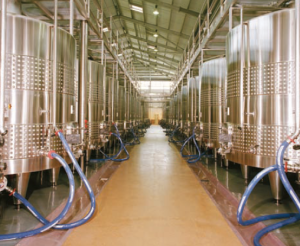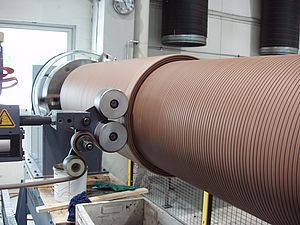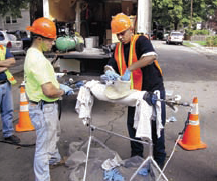There are many factors at play when making wine. For its annual production of five million bottles, the French wine cooperative USPDE in Saint-Emilion uses 1,500 meters of hygienic hoses.
The Union de Producteurs de Saint-Emilion (UDPSE) was the first ever wine cooperative in the Gironde – a département that includes the Bordeaux wine producing region and covers 120,000 hectares of vines. Only ten producers formed the cooperative back in 1932. Currently, it brings together 187 wine growers with 800 hectares of vines, accounting for sales of EUR 27 M in 2008.
“We distribute some five million bottles of wine annually, 42 percent of which are exported,”says Bertrand Bourdil, Technical Directorat UDPSE. “Unlike other cooperatives that sell wine whole sale to wine traders, we bottle all our production and are totally autonomous in terms of production and distribution.” Sixty individual châteaux account for 60 percent of UDPSE’s business, with the remaining 40 percent comprising blended wines withthe co-op’s own brands. “For us, the key is authenticity – we are continuing the great name of Saint-Emilion through fine wines that have a ‘handcrafted’ feel, despite oursize,” Bourdil explains.
Indeed UDPSE has invested some EUR 8.5 million in a state-of-the-art winery with a capacity of two million liters that can receive up to 800 tons of grapes per day. “Our châteaux range from 0.35 hectare to about 20, but those producers know they can count on us to make the very best wine from their grapes with its own unique character,” says Bourdil.
Saint-Emilion wines are made from 80 percent Merlot, 15 percent Cabernet Franc and five percent Cabernet Sauvignon grapes, and the UDPSE team works very closely with producers throughout the year, awarding bonuses to those who best meet the quality standards established by the co-op. Careful checks on the vines are carried out to ensure the optimum date for the vendange, or wine harvest,which spells the end of the wine grower’s involvement.The quality of each batch is controlled on arrival, and the grower’s payment is instantly calculated, depending on quantity and quality.
The grapes are carefully transferred using gravity into stainless-steel vats, each containing10,000-20,000 litres, where they macerate for up to four days. Yeasts are added and the temperature is raised to 20-22°C to trigger fermentation. This continues for about a week and the wine is subsequently macerated again for a fortnight before being pressed and racked off. It is then put into barrels in the dark cellar underneath the winery, which holds around 5,300 barrels. Some months later, the wines are fined where chemicals are used for clarification, removing all solids.They are then bottled the following spring.
The cooperative’s wines range in price from EUR 5 to EUR 28, and the bestseller is called Aurélius. “Aurélius was the co-op’s first branded wine, and it is a blend of wines from the eight communes that make up the appellation that we think truly represents a Saint-Emilion,” says Bourdil. Some 50,000 bottles of Aurélius are sold every year.
“The key to a great wine is quality, which you get from treating wine with respect. We only use hoses from Trelleborg and have over 1,500 meters at present,” says Bourdil. The hoses are utilized wherever the wine needs to be transferred, such as from the vats to the barrels. “When we upgraded from the Citerdial to the Vinitrell hose, we were very happy,apart from the fact the hoses were red, which isn’t a color the winery team associates with hygiene. We asked Trelleborg to make us blue ones instead, which they did. We have always enjoyed a very good relationship with the company; one of mutual respect and cooperation– I’ll drink to that!”
Red wine through
Hygienic Blue Hoses
- by Trelleborg Industrial Solutions
- September 23, 2009
- 186 views





















